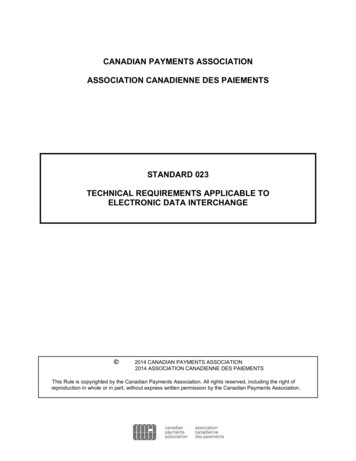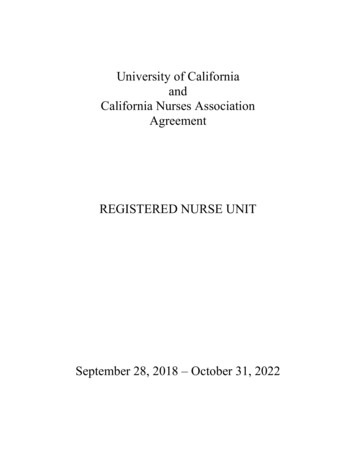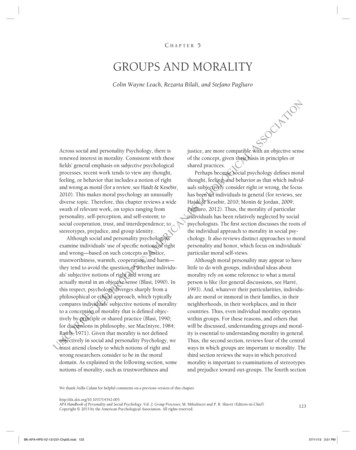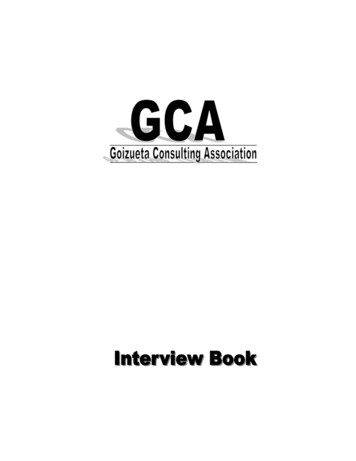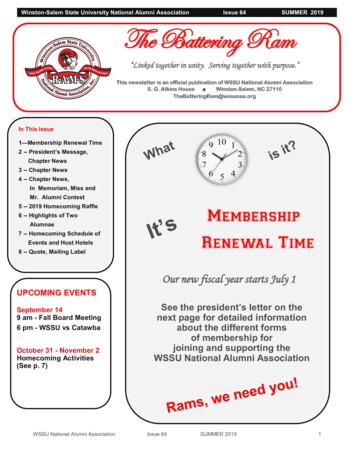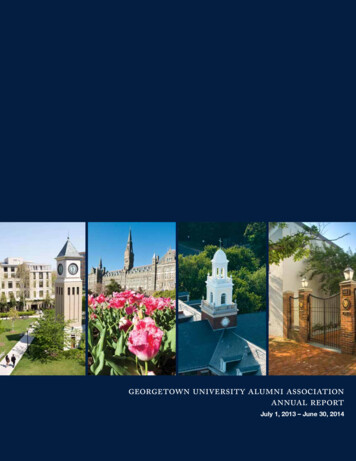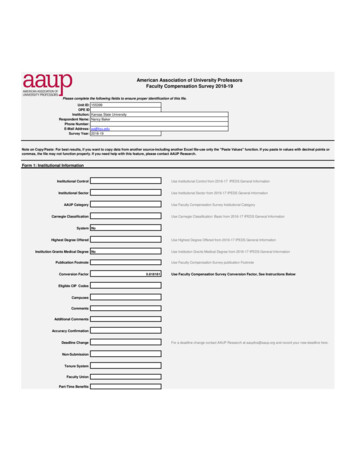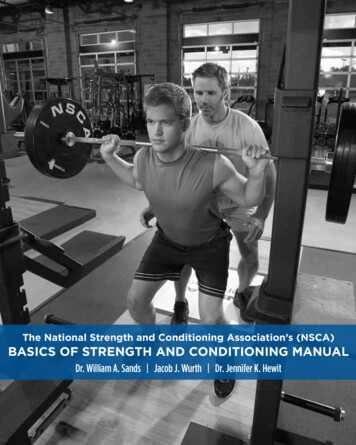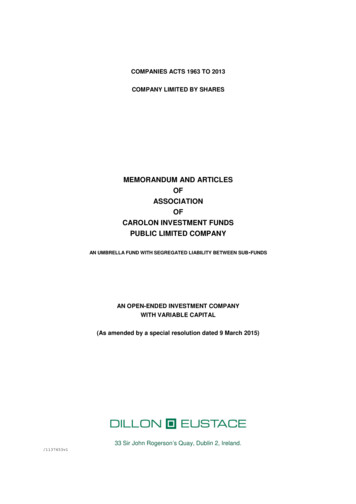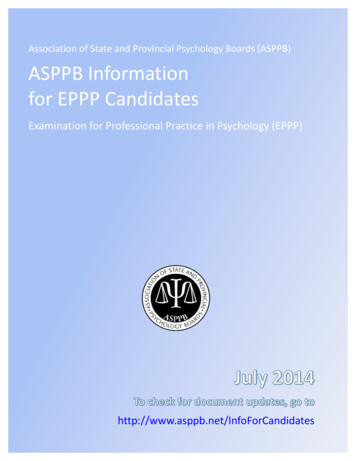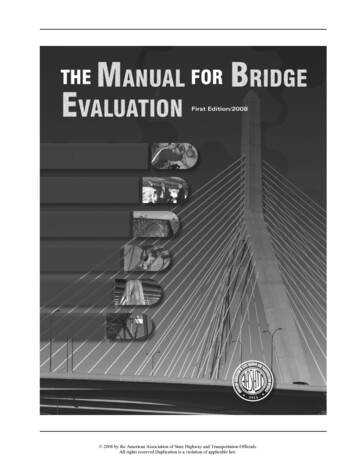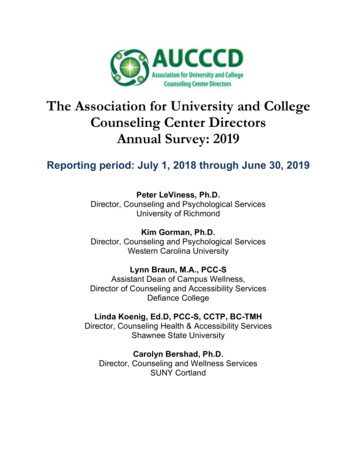
Transcription
The Association for University and CollegeCounseling Center DirectorsAnnual Survey: 2019Reporting period: July 1, 2018 through June 30, 2019Peter LeViness, Ph.D.Director, Counseling and Psychological ServicesUniversity of RichmondKim Gorman, Ph.D.Director, Counseling and Psychological ServicesWestern Carolina UniversityLynn Braun, M.A., PCC-SAssistant Dean of Campus Wellness,Director of Counseling and Accessibility ServicesDefiance CollegeLinda Koenig, Ed.D, PCC-S, CCTP, BC-TMHDirector, Counseling Health & Accessibility ServicesShawnee State UniversityCarolyn Bershad, Ph.D.Director, Counseling and Wellness ServicesSUNY Cortland
AUCCCDThe Association for University and College Counseling Center Directors (AUCCCD) isan international organization comprised of colleges and universities from the UnitedStates and its territories, Armenia, Australia, Canada, China, France, Grenada, Ireland,Japan, Oman, Qatar, St. Kitts Nevis Anguilla, Uganda, and the United Kingdom.AUCCCD works to be the higher education leaders for collegiate mental health.“We are a professional community that fosters director development andsuccess. To advance the mission of higher education, we innovate, educate andadvocate for collegiate mental health. We are committed to inclusive excellence andthe promotion of social justice.”The AUCCCD Annual Survey OverviewIn 2006, AUCCCD first developed and administered the Annual Survey to itsmembership as a means to increase the objective understanding of factors critical to thefunctioning of college and university counseling centers.In July, 2019, all (non-emeriti) members of AUCCCD, plus 49 non-members who askedto participate, were invited to complete the annual survey. Unique survey links weresent to 930 verified email accounts. A total of 562 counseling center directorsresponded to the 2019 survey, 540 of which were AUCCCD members. Thisrepresented 63.8% of the 881 total AUCCCD (non-emeriti) members as of October 19,2019.The reporting period for the information on the 2019 Annual Survey was July 1, 2018through June 30, 2019. This monograph provides a summary of the data reported in the2019 AUCCCD Annual Survey. AUCCCD members have access to a separatemonograph with identical tables that also includes responses to questions about ethicaldilemmas and legal issues experienced by centers.1
For the second year in a row, center staff and salary data were collected viaspreadsheets sent to each center (aka the “2019 Staff and Salary Spreadsheet”), ratherthan including these questions on the online survey. 287 of the 881 AUCCCD members(a 32.6% response rate) completed and sent back staff and salary spreadsheets. Thisis a significant increase over the 19.2% that contributed staff and salary spreadsheetslast year. It is expected that the response rate to the staff and salary spreadsheets willcontinue to increase in future years, as more and more directors begin to track this data.In this monograph, most of the director and staff demographic questions, and staff FTEdata are from the 287 completed spreadsheets.A separate “College and University Counseling Center Salary Tables” monograph hasbeen prepared using the salary data from the 287 spreadsheets, and is available on themembers-only section of the AUCCCD website (https://www/aucccd.org).Please direct all questions, comments, and clarifications to the AUCCCD SurveyCoordinator:Peter LeViness, Ph.D.Director, Counseling and Psychological ServicesUniversity of Richmondplevines@richmond.edu2
Table of ContentsEXECUTIVE SUMMARYCENTER INFORMATIONINSTITUTIONAL DIVISION CENTER IS INMONTHS OF YEAR CENTER IS OPEN FOR COUNSELING SERVICESCENTER SALARY AND BENEFITS BUDGETCENTER OPERATING EXPENSES BUDGETCENTER PROFESSIONAL DEVELOPMENT BUDGETCENTER IS ADMINISTRATIVELY INTEGRATED WITH OTHER OFFICE(S)INTEGRAL PARTS OF CENTERS’ MISSIONCASE MANAGERS: CENTERS WITH STAFF THAT PROVIDE CASE MANAGEMENT FUNCTIONSCASE MANAGERS: SERVICES PROVIDED BYEMBEDDED COUNSELORS: CENTERS THAT HAVE ANYEMBEDDED COUNSELORS: HOURS PROVIDED AT EACH LOCATIONSESSION LIMIT: CENTERS THAT HAVE ANYSESSION LIMIT TYPESESSION LIMIT PER ACADEMIC YEARAVERAGE WAIT FOR FIRST APPOINTMENTAVERAGE WAIT FOR FIRST APPOINTMENT AFTER TRIAGE APPOINTMENTSTEPPED CARETELE-HEALTH SERVICESCENTER MEMBERSHIPS133334455677788899101011CENTER CLINICAL SERVICES PROVIDED12UNIQUE NUMBER OF STUDENTS SERVED BY CENTER (EXCLUDING COMMUNITY COLLEGES)12UNIQUE NUMBER OF STUDENTS SERVED BY CENTER: COMMUNITY COLLEGES ONLY12PERCENT OF CAMPUS SERVED BY COUNSELING SERVICES*12PERCENT OF CAMPUS SERVED BY COUNSELING SERVICES: COMMUNITY COLLEGES ONLY13CRISIS APPOINTMENTS: DURING NORMAL OFFICE HOURS13CRISIS APPOINTMENTS: AFTER NORMAL OFFICE HOURS13TRIAGE APPOINTMENTS: DO CENTERS OFFER TRIAGE APPTS14TRIAGE APPOINTMENTS: AVERAGE NUMBER ATTENDED14TRIAGE APPOINTMENTS: HOW CENTERS PROVIDE THEM15TRIAGE APPOINTMENTS: TYPICAL LENGTH15INDIVIDUAL COUNSELING: UNIQUE NUMBER OF CLIENTS (EXCLUDING COMMUNITY COLLEGES) 16INDIVIDUAL COUNSELING: UNIQUE NUMBER OF CLIENTS (COMMUNITY COLLEGES ONLY)16INDIVIDUAL COUNSELING: TOTAL APPOINTMENTS ATTENDED (EXCLUDING COMMUNITY COLLEGES)16INDIVIDUAL COUNSELING: TOTAL APPOINTMENTS ATTENDED (COMMUNITY COLLEGES ONLY)16INDIVIDUAL COUNSELING: AVERAGE APPOINTMENTS ATTENDED (EXCLUDING COMMUNITYCOLLEGES)17INDIVIDUAL COUNSELING: AVERAGE APPOINTMENTS ATTENDED (COMMUNITY COLLEGES ONLY) 17PSYCHIATRIC: ARE ANY PSYCHIATRIC SERVICES AVAILABLE ON CAMPUS17PSYCHIATRIC: UNIQUE NUMBER OF CLIENTS WHO USED PSYCHIATRIC SERVICES18PSYCHIATRIC: TOTAL NUMBER OF PSYCHIATRIC SESSIONS18PSYCHIATRIC: AVERAGE NUMBER OF PSYCHIATRIC SESSIONS193
PSYCHIATRIC: AVERAGE NUMBER OF PSYCHIATRIC HOURS PER WEEK AT INSTITUTIONPSYCHIATRIC: HOW SUFFICIENT WERE THE AVAILABLE PSYCHIATRIC HOURSGROUPS: NUMBER OF GROUPS CENTER RAN (EXCLUDING COMMUNITY COLLEGES)GROUPS: NUMBER OF GROUPS CENTER RAN (COMMUNITY COLLEGES ONLY)GROUPS: NUMBER OF GROUP SESSIONS PROVIDED (EXCLUDING COMMUNITY COLLEGES)GROUPS: NUMBER OF GROUP SESSIONS PROVIDED (COMMUNITY COLLEGES ONLY)GROUPS: UNIQUE STUDENTS WHO ATTENDED (EXCLUDING COMMUNITY COLLEGES)GROUPS: UNIQUE STUDENTS WHO ATTENDED (COMMUNITY COLLEGES ONLY)TRAINING: TOTAL INDIVIDUALS WHO ATTENDED CENTER TRAINING EVENTSOUTREACH: TOTAL INDIVIDUALS WHO ATTENDED CENTER OUTREACH EVENTS19192020202021212222CENTER CLIENTSCLIENT PRESENTING PROBLEMSACADEMIC IMPACT OF COUNSELING SERVICESDEMOGRAPHICS OF CENTER CLIENTSFIRST APPOINTMENT WAS A CRISISCLIENTS SENT TO HOSPITAL FOR PSYCHOLOGICAL REASONSCLIENTS ADMITTED TO HOSPITAL FOR PSYCHOLOGICAL REASONSNUMBER OF INVOLUNTARY HOSPITALIZATIONSCLIENTS WHO ATTEMPTED SUICIDECLIENTS WHO DIED BY SUICIDE23232324242525252626CLINICAL LOAD INDEX, SERVICE DEMAND, STRATEGIES FOR MANAGING DEMANDCLINICAL CAPACITY OF CENTER BY SIZE OF INSTITUTION (EXCLUDING COMMUNITY COLLEGESCLINICAL CAPACITY OF CENTER BY SIZE OF INSTITUTION (COMMUNITY COLLEGES ONLY)STANDARDIZED COUNSELORS BY SIZE OF INSTITUTION (EXCLUDING COMMUNITY COLLEGES)STANDARDIZED COUNSELORS BY SIZE OF INSTITUTION (COMMUNITY COLLEGES ONLY)CLINICAL LOAD INDEX (CLI) BY SIZE OF INSTITUTIONCENTERS THAT EXPERIENCED INCREASED DEMAND FOR SERVICESCENTERS THAT EXPERIENCED INCREASED DEMAND FOR SERVICES: BY SCHOOL SIZEINCREASE IN NUMBER OF CLIENTS SERVEDINCREASE IN NUMBER OF APPOINTMENTS PROVIDEDPERCENT INCREASE IN NUMBER OF CLIENTS SEEKING SERVICESPERCENT INCREASE IN NUMBER OF COUNSELING APPOINTMENTS OFFEREDPERCENT INCREASE IN NUMBER OF CLIENTS AND COUNSELING APPOINTMENTS: CATEGORIESSTRATEGIES USE TO MANAGE INCREASED DEMANDCENTER POLICY ABOUT FREQUENCY OF INDIVIDUAL COUNSELING APPOINTMENTS272727282828292929303030313131CENTER STAFFDEMOGRAPHICS OF CENTER STAFFFTE OF PROFESSIONAL / CLINICAL (“TALK THERAPY”) TRAINEESFTE OF SUPPORT STAFFSTAFF TURNOVER IN PAST YEARSTAFF TURNOVER: WAS LOW SALARY A FACTORSTAFF TURNOVER: WERE DIFFICULT CENTER WORK CONDITIONS A FACTORSTAFF TURNOVER: OTHER REPORTED FACTORSSTAFF POSITIONS GAINED OR LOST: PAST YEARSTAFF POSITIONS GAINED OR LOST: MULTIPLE YEAR TRENDSTUDENT TO COUNSELING STAFF RATIO (“TALK THERAPY” FTE STAFF ONLY)32323334343435353636364
STUDENT TO COUNSELING STAFF RATIO (“TALK THERAPY” FTE STAFF TRAINEES)NUMBER OF STUDENTS SERVED PER FTE “TALK THERAPY” STAFF AND TRAINEES3737DIRECTOR INFORMATIONDIRECTOR: RACEDIRECTOR: GENDER IDENTITYDIRECTOR: SEXUAL ORIENTATIONDIRECTOR: DOCUMENTED DISABILITYDIRECTOR: HIGHEST DEGREEDIRECTOR: PROFESSIONAL IDENTITYDIRECTOR: YEARS OF EXPERIENCE AS DIRECTOR IN CURRENT POSITIONDIRECTOR: TOTAL YEARS OF PROFESSIONAL EXPERIENCEDIRECTOR: LICENSE OR BOARD CERTIFICATIONDIRECTOR: IS DIRECTOR POSITION FULL-TIME 12 MONTHSDIRECTOR: HOURS WORKS PER WEEKDIRECTOR: DIRECTORS OF ONE-PERSON CENTERSDIRECTOR: AREAS / FUNCTIONS DIRECTOR OVERSEES3838383838393939404040404041INSTITUTIONAL INFORMATIONCOUNTRY INSTITUTION IS LOCATED INSTATE INSTITUTION IS LOCATED INSCHOOL LOCATIONSCHOOL SIZE (ENROLLMENT CATEGORIES)SCHOOL STATUSPERCENT OF ENROLLED UNDERGRADUATE STUDENTS WHO LIVE ON-CAMPUSINSTITUTIONAL AFFILIATIONS4242424243434344PARTICIPATING COLLEGES AND UNIVERSITIES455
Executive SummaryA total of 562 counseling center directors responded to the 2019 AUCCCD survey. Amongparticipants, 465 indicated current membership to the Association for University and CollegeCounseling Center Directors (AUCCCD). This represents a 69.4% response rate from AUCCCDmembers, the second highest ever for this survey.Counseling services improve retention and student academic performanceCounseling centers are clearly serving as "high impact practices" that help keep studentsengaged in and retained by their institutions:(1) Counseling services have a positive impact on academics: 66.2% of clients stated thatcounseling services helped with their academic performance.(2) Counseling services have a positive impact on retention: 62.3% of clients stated thatcounseling services helped them stay in school.Institutions continue to invest additional resources in counseling services:43.9% of centers gained staff positions, while only 5.1% lost staff positions. For the 471centers who responded to this question, a total of 325.4 FTE staff positions were gained, while 22.0positions were lost, for a net gain of 303.4 FTE counseling positions. Institutions of highereducation continue to invest in counseling services: for at least the past seven years, counselingcenters have gained an average of 0.5 staff positions per center per year.Anxiety continues to be the most frequent concern among college counseling center clientsThe most frequent concern for counseling center clients was anxiety (60.7%), followed bydepression (48.6%), stress (47.0%), family concerns (29.0%), specific relationship problems (27.0%),academic performance difficulties (26.2%), sleep disturbance (17.7%), social isolation / loneliness(17.5%), trauma (17.2%), adjusting to a new environment (17.0%), and suicidal thoughts (14.4%), andeating/body image concerns (13.6%).An average of 23.5% of center clients were taking prescribed psychiatric medication.Demand for Services87.3% of directors reported experiencing an increased demand for counseling services in thepast year. Directors reported that, on average, 12.2% more clients were served in 2019 than in 2018.Similarly, centers offered, on average, 12.3% more appointments in 2019 as compared to 2018.The most frequent strategies centers used to manage this increase were: triaging clientsbased on urgency (45.0% reported this strategy), referring more clients off campus for services(38.1%), and reducing outreach offerings (30.8%).Directors reported, on average, 13.3% of their campus served by the counseling center.Counseling centers at smaller institutions tend to serve significantly greater percentages of their entirestudent population.Stepped Care37.2% of counseling centers used a version of stepped care, which refers to offering acampus-wide menu of service options ranging from no care at all to weekly therapy at the counselingcenter. Depending on the center, options may include appropriate forms of self-help, wellnesscoaching, support groups, mindfulness classes, appropriate apps and online resources, etc. Astepped care model was much more likely to be used at the largest centers (76.5%) than at thesmallest centers (7.8%).Case Managers in the Counseling Center1
41.4% of centers have one or more staff who provide case management functions now,compared to only 7.2% in 2007-8. This represents about a 600% increase over the past 12 years.Turnover in Counseling Center Staff43.5% of centers had staff turnover in the past year. For centers that experienced turnover,56.5% reported that low salary was a factor staff decisions to leave, compared to 40.9% in the 2018survey. 43.9% of centers reported that center work conditions were a factor in staff decisions toleave, compared to 36.5% in the 2018 Survey.Clinical Load IndexFor the second year in a row, the Clinical Load Index (CLI) was calculated for each center thatprovided the necessary data. The CLI seems promising as a new method for evaluating andcomparing counseling center clinical resources.Psychiatric Services on Campus66.3% of directors reported that psychiatric services are offered on their campus. 56.3% ofdirectors whose centers have psychiatric services reported that they need more hours of psychiatricservices than they currently have to meet student needs.Session Limits54.1% of centers do not have a session limit, another 46.4% have a flexible session limit (statea limit but exceptions are made), and only 0.4% have a “hard” session limit (no exceptions). Forcenters that have a session limit, the average limit is 12.6 sessions per academic year.Frequency of Appointments41.6% of directors report that most clients are seen for weekly appointments. 37.1% reportthat clients are seen, on average, every 2 weeks.Wait for a First AppointmentThe average wait for all clients for a first appointment was 6.1 business days. The averagewait from the time of students' triage appointment to the time of their next clinical appointment was 8.7days.Counselors Embedded in Other Campus Locations19.7% of centers have counselors embedded in other offices on campus. Of those with anembedded counselor, centers reported having 61.6 weekly hours in a school/college at the university,38.6 weekly hours in health services, 32.9 weekly hours in residence halls, 26.3 weekly hours inathletics, 15.9 weekly hours in under-represented students offices, and 31.8 weekly hours in otherlocations.2
Center InformationInstitutional Division Center Is InInstitutional Division Center Is InStudent Affairs / Student Development / Student LifeAcademic Affairs / Academic & Student AffairsEnrollment Management & Student AffairsHealth services (if not part of Student Affairs)Student Success / Support ServicesOtherTOTALMonths of Year Center is Open for Counseling ServicesMonths of the Year Center isOpen for Counseling ServicesTOTALSchool SizeCenters9 or Less10Under 1,5015230.8%32.7%1,501 - 2,5007025.7%24.3%2,501 - 5,000897.9%12.4%5,001 - 7,500458.9%11.1%7,501 - 10,000385.3%5.3%10,001 - 15,0005501.8%15,001 - 20,000380020,001 - 25,0002803.6%25,001 - 30,000230030,001 - 35,000160035,001 - 45,000190045,001 and over1700TOTAL490214130Center Salary and Benefits BudgetCenter Salary and Benefits Budget(not including operating expenses)# ofSchool SizeCentersMeanMedianUnder 1,50131 191,053 154,0001,501 – 2,50027 296,121 262,1402,501 – 5,00060 440,328 343,1075,001 – 7,50020 413,082 442,7507,501 – 10,00024 724,455 700,21810,001 – 15,00037 1,013,536 759,41315,001 – 20,00027 1,473,186 1,190,59320,001 – 25,00017 1,477,673 1,211,18925,001 – 30,00015 1,857,664 1,863,69930,001 – 35,00012 2,350,879 2,043,25635,001 – 45,00017 2,816,392 2,408,50345,001 and over11 3,305,358 2,989,366Total298 1,035,895 570,817# of 7%100.0%63Minimum 32,000 65,000 83,000 79,938 116,000 127,650 332,884 515,443 490,000 1,151,131 1,231,480 1,953,984 32,000Maximum 550,000 711,000 1,640,582 933,705 2,215,649 5,063,688 4,759,743 4,100,000 5,000,000 4,327,216 6,488,700 5,181,406 6,488,7003
Center Operating Expenses BudgetCenter Operating Expenses Budget(not including salary and benefits)# ofSchool SizeCentersMeanMedianMinimumUnder 1,50138 13,810 8,544 1,1001,501 – 2,50049 52,738 20,631 3,0002,501 – 5,00068 67,570 28,968 3,4005,001 – 7,50033 22,394 18,172 3,4027,501 – 10,00028 37,198 23,628 2,88510,001 – 15,00039 60,824 39,000 4,66015,001 – 20,00026 122,365 78,381 11,66320,001 – 25,00015 94,320 55,861 7,65125,001 – 30,00014 109,903 95,706 17,00030,001 – 35,00012 225,859 170,727 18,77535,001 – 45,00016 352,629 124,500 19,62245,001 and over10 1,146,400 461,436 70,000Total348 108,643 30,566 1,100Maximum 65,599 786,000 680,000 95,242 192,584 250,000 548,000 250,000 235,422 900,000 2,977,142 4,633,561 4,633,561Center Professional Development BudgetProfessional Development Budget for All Staff(including travel, registration, related costs)School Size# ofCentersMeanMedianMinimumUnder 1,50141 3,213 2,000 4001,501 – 2,50049 6,211 4,400 1002,501 – 5,00065 5,744 5,000 4505,001 – 7,50029 4,817 4,000 8507,501 – 10,00027 7,093 5,163 75010,001 – 15,00042 11,825 9,000 55515,001 – 20,00029 16,099 12,313 2,00020,001 – 25,00016 17,019 15,500 1,50025,001 – 30,00015 20,397 17,000 400Maximum 18,000 50,000 23,900 15,216 31,000 34,000 54,000 42,000 60,00030,001 – 35,00035,001 – 45,00045,001 and overTotal131310349 32,068 24,748 38,333 10,901 34,500 19,000 30,000 6,000 5,000 3,500 1,000 100 55,000 55,000 92,500 92,5004
Center is Administratively Integrated With Other Office(s)Administratively Integrated With# of CentersPercentNONE (Center is NOT integrated with any other office)22347.0%Alcohol and Other Drug Education10321.6%Alcohol and Other Drug Treatment8517.8%Career81.7%Disability Services357.3%Employee Assistance Program71.5%Health Promotion12225.6%Health Services11423.9%Learning 0.0%Other Offices/Functions Integrated With Center included: Collegiate Recovery, Dental Services,Nutrition Services, Peer Support, Victim Advocacy, Violence Prevention, Wellness Programming.Integral Parts of Centers’ MissionAreas That Represent Integral Parts of Centers’ Mission# of CentersPercentCampus outreach43891.3%Career counseling418.5%Career testing214.4%Clinical supervision of trainees35373.5%Clinical supervision of unlicensed staff employees23348.5%Community outreach (i.e., off-campus)5311.0%Couples therapy16734.8%Crisis intervention46797.3%Direct clinical service480100.0%Meetings with other offices and departments39782.7%Neuropsychological testing/assessment377.7%Psychoeducational groups/workshops39081.3%Research, to understand trends/needs at your institution18137.7%Research for potential publication316.5%Staff/faculty training40584.4%Student affairs/student develop. committees/work groups35974.8%Student worker training (e.g., RAs)23348.5%Teaching courses for academic credit296.0%Teaching non-academic credit courses173.5%University committees or working groups28559.4%Other*439.0%TOTAL CENTERS480100.0%* Other Integral Part of Center's Mission included: BIT/CARE team involvement; Case Management;Clinical Consultation; Consultation with faculty, staff, parents, etc; New student and parent orientation;Suicide prevention training; Supervising peer educators; Supervision of peer hotline; ThreatAssessment Team involvement; Wellness programming5
Case Managers: Centers With Staff That Provide Case Management FunctionsCenters With Staff Providing Case Management FunctionsSchool Size# of CentersNoYesUnder 1,5015078.0%22.0%1,501 – 2,5006976.8%23.2%2,501 – 5,0008770.1%29.9%5,001 – 7,5004386.0%14.0%7,501 – 10,0003754.1%45.9%10,001 – 15,0005360.4%39.6%15,001 – 20,0003745.9%54.1%20,001 – 25,0002748.1%51.9%25,001 – 30,0002321.7%78.3%30,001 – 35,0001612.5%87.5%35,001 – 45,000190.0%100.0%45,001 and over175.9%94.1%TOTAL47858.6%41.4%Larger in
May 31, 2020 · For the second year in a row, center staff and salary data were collected via spreadsheets sent to each center (aka the “2019 Staff and Salary Spreadsheet”), rather than including these questions on the online survey. 287 of the 881 AUCCCD members (a 32.6% response rate) completed and sent
